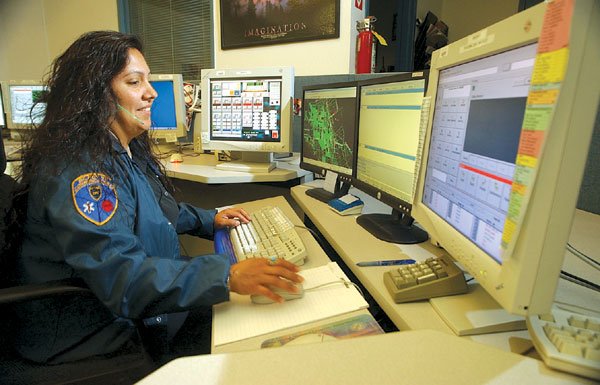Gilroy
– Heard but not seen, police and fire dispatchers are on the
front lines of any Gilroy emergency.
When a resident calls 911, they answer
– 24 hours a day, seven days a week – and gather valuable
information.
Then they send help.
By Lori Stuenkel
Gilroy – Heard but not seen, police and fire dispatchers are on the front lines of any Gilroy emergency.
When a resident calls 911, they answer – 24 hours a day, seven days a week – and gather valuable information.
Then they send help.
Gilroy’s dispatchers, called public safety communicators, handle hundreds of emergency and non-emergency calls each day. On Wednesday, the mid-point of National Public Safety Telecommunicators Week, calls included a suspicious-looking motor home, a possible fight at a high school and an elderly woman who whispered numbers into the phone, not realizing she’d dialed 911.
It was a slow morning, agreed Cheri Carreiro, a public safety communicator, and Patty Harrell, a senior public safety communicator. Each sat facing four computer monitors that displayed, among other things, the locations of police officers and fire engines, information about the phone numbers from which 911 calls are made, and a visual display of the city’s radio frequencies.
A list of calls-in-progress on one screen showed officers working four different situations, and another screen showed two low-priority items to dispatch when needed.
When a 911 call came in, Harrell quickly answered. Her responsibility for the day was the Gilroy Fire Department radio and to answer phone calls, while Carreiro handled the Gilroy Police Department radio.
“You have to be well-versed in all of it, but we have our favorites,” Harrell said.
The caller was reporting a domestic disturbance, and as Harrell typed up information while the caller spoke, Carreiro dispatched police officers and relayed what Harrell knew.
Dispatchers are champions at multi-tasking.
They answer phones while listening to police or fire radios, typing up information for both. They might be working on all four of their monitors at once, if officers or fire engines are on the move, a call is on the line, and they have to radio instructions.
“Every day is different, and it is nice to know that when you leave, you may have made a difference in people’s day,” Harrell said.
Most dispatchers do not expect to hear thanks from callers, she said, because they are dealing with critical situations.
“You don’t expect positive conversations, but you’re left with a positive feeling, usually, because people are safe,” Harrell said.
But it’s the not knowing whether people are safe that make dispatching one of the most stressful occupations.
“A lot of their stress is job-related, and it’s just the lack of closure,” Harrell said.
Still, local dispatchers may get more closure than those who work for larger departments and may never even meet the officers with whom they communicate. In Gilroy, officers will stop by the communication center, situated across the hall from their locker room, and give the dispatchers the rest of the story.
Another small-town advantage, or disadvantage at times, is that Gilroy dispatchers recognize many of the names that come across their screens. They memorize the addresses and even dates of birth of some people who are arrested time and again.
“You may get calls from people you know,” Harrell said. “It makes it interesting if they see you out in public, because they might be embarrassed. But we keep it all confidential.”
Having access to a wealth of databases and maps, the dispatchers can look up their history with a person, phone number, or address, and alert the responding officer to any red flags about the situation.
“A lot of agencies don’t have that capacity, or they don’t choose to use it,” Carreiro said.
Gilroy’s dispatchers prioritize keeping that information up-to-date so it is as useful as possible. Still, they worry about the safety of officers they send into critical situations.
“They’re your extended family,” Harrell said. “That’s not me saying that, it’s this profession. Whether you’re sending firefighters into a fire, or police officers into a hostile situation, your goal at the end of the day is that everybody goes home.”
Not surprisingly, the dispatch center is swamped when a major call comes in. For example, a fire garners dozens of calls from people who see or smell the smoke.
Then there’s the rest of the calls: Someone who wonders how they can re-schedule a court date, or a man in Taft who needs police assistance. From Gilroy, all dispatchers can do is politely refer people to the number they should be calling.
Eleven full-time and two part-time dispatchers are the voices on the other end of 911. This summer, with one more full-time person, they will be fully staffed, a prospect that delights most because it’s been a rough couple of years, Harrell said. At the low point, there were no more than six full-time dispatchers. Instead of the usual 10-hour shifts, four days a week, they racked up 12- or even 18-hour days.
Even in an occupation for people who thrive on adrenaline, the overtime was a grind.
The dispatchers are being pampered this week, a recognition of public safety communicators nation-wide held the second week of April each year. They’ve received flowers, lunch, balloons, a banner and firefighters will cook them dinner this weekend.
Just don’t call 911 to say ‘thanks.’
The 411 on 911
Gilroy 911 Public Safety Communicators:
– Work 10-hour shifts, four days a week. Eleven are full-time, two are part-time
– Receive 80 to 150 emergency calls each day, and hundreds more non-emergency calls
– Have from five to more than 20 years of experience
– Train between four and six months on the job, after completing a three-week academy














